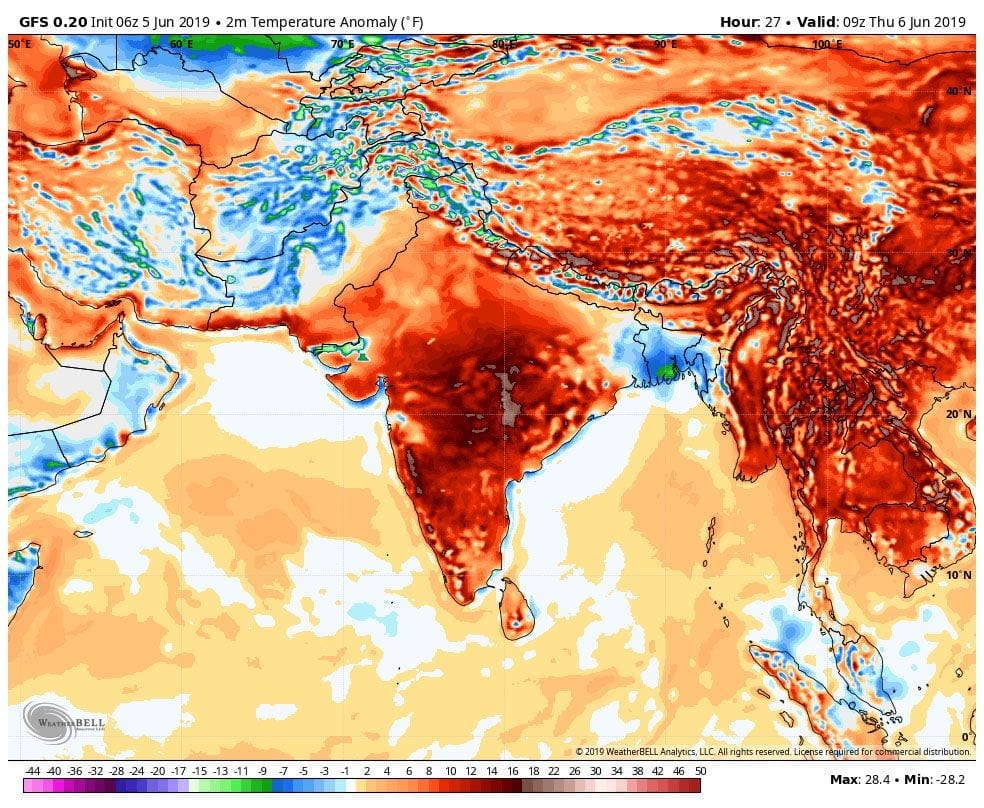The mountains in Himachal Pradesh, India have been home to me, ever since I started coming here in 2007. It gave me a respite from the Indian cities’ summer heat and pollution.
But this year has been different. The summer has been extremely warm, with temperatures ranging between 30-32°C since May. But on Tuesday, June 10 the temperature hit 35°C during the daytime. I tried running the fan on full speed but to no avail, as more warm air just blew around me. I realised this is the warmest the mountains have been for me ever since I moved here.
Worst ever heatwave in India
On the same day, the temperature in India’s capital New Delhi reached 48°C, a record high for the national capital in June. India is witnessing its worst ever heatwave, with four cities in North India on a record high.

(WeatherBell Analytics) Washington Post This forecast for Thursday shows the temperature difference from normal (in Fahrenheit). Red shades show areas where the temperature is hotter than normal.
Delhi records the highest #temperature in history. Sets an all-time record at 48°C. This is the #hottest ever in June. #Delhi #Heatwave #DelhiSummer #DelhiHeat
— SkymetWeather (@SkymetWeather) June 10, 2019
This is no coincidence.
Other than Delhi, Churu in Rajasthan, Allahabad, and Banda in Uttar Pradesh touched 48°C and above, reported NDTV.
Churu witnessed 50°C twice in one week, an increase of 8 degrees above normal. The rising heat forced its residents to adjust their daily schedules altogether. Farmers have to start farming at 4 am to avoid the midday heatwave and stay inside their homes during the day. Local authorities started hosing down the baked streets.
The heatwaves are also taking a toll on human health and life. Four passengers on a long-distance train died from heatstroke, reported Livemint. “Heat seems to be a factor,” Indian Railways spokesman Ajit Kumar Singh told AFP, “it is really unfortunate”.
A Climate Crisis is here:
Many on social media lamented how the heatwaves have been increasing over the years as India still keeps burning fossil fuels.
Delhi burns at 48 degrees. Exactly a week ago, 11 of the 15 hottest places in the world were in India. Do climate deniers feel the heat as we lose our forests & turn cities into gas chambers? #ClimateChangeIsReal #heatwave https://t.co/V9vR5wQvRl
— Anindita Datta Choudhury (@anindita2tweets) June 10, 2019
This is why acting on #ClimateChange & moving away from polluting fuels of past #Coal & #Oil is even more important for India
“Exactly a week ago, 11 of the 15 hottest places in the world were in India, the rest were in neighbouring Pakistan” #Heatwave https://t.co/NBnlXiWukr— Sunil Dahiya (@Sunil_S_Dahiya) June 10, 2019
Air is polluted, we’ve run out of water, heatwave is breaking all records, 16 states in india have declared drought! #ClimateCrisis is not on the door, it has smashed through the wall with a bulldozer and ruining everything in its path. #ClimateActionNow
— Brikesh (@Brikesh) June 12, 2019
Heatwaves have become increasingly frequent in India over the last few years. 2018 was the sixth warmest year since record-keeping began in 1901, and 11 of the 15 warmest years have occurred since 2004, according to Washington Post. The intense heat could be another manifestation of an extreme weather event, say experts from the Indian research organization Centre for Science and Environment. India’s heat waves have resulted in the death of over 22,000 people since 1992, according to the National Disaster Management Authority (NDMA).
“Science, as well as our subjective experiences, has made it unequivocally clear that longer, hotter and deadlier summers are poised to become the norm due to climate change,” wrote Hem Dholakia, an environmental researcher.
This is why India needs to take a step away from burning coal, oil, and gas. The government has taken some steps in harnessing solar power. Further investments in decentralised solar power will ween the country off of fossil fuels. As citizens, we need to lobby our government to prioritise rooftop solar and decrease coal subsidies and ending coal over a period of time.
Hundreds of school students skipped schools in India on Fridays to join the global schools strikes for the climate. They demanded that the government reduce carbon emissions before it is too late. As adults failed miserably to do the needful actions, young people have taken it upon themselves to call for sustained action. It is time we adults join them in this fight.
We might not be able to able to stop climate change, but we can take steps to minimise its effects by building a fossil free movement. Join young students as they mobilise for a Global Climate Strike on September 20, 2019.